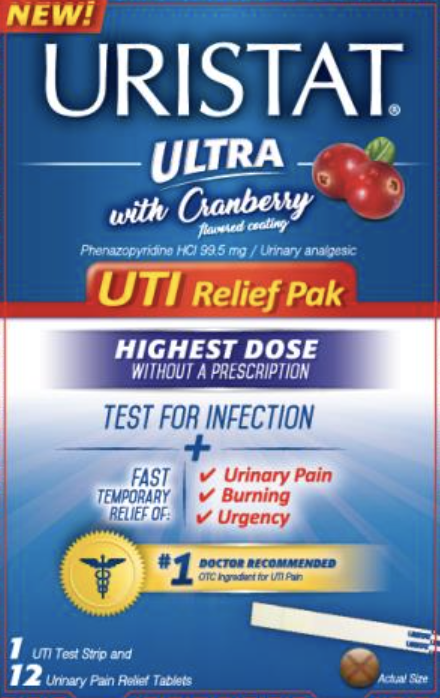Uristat Ultra Disease Interactions
There are 3 disease interactions with Uristat Ultra (phenazopyridine).
Phenazopyridine (applies to Uristat Ultra) G-6-PD deficiency
Major Potential Hazard, Moderate plausibility.
Patients with glucose-6-phosphate dehydrogenase (G-6-PD) deficiency may be at increased risk for phenazopyridine-induced methemoglobinemia and hemolytic anemia. These conditions have occurred rarely in other patients, except due to acute phenazopyridine overdose or impaired renal function. Therapy with phenazopyridine should be administered cautiously in patients with G-6-PD deficiency.
Phenazopyridine (applies to Uristat Ultra) hepatitis
Major Potential Hazard, Moderate plausibility. Applicable conditions: Liver Disease
The use of phenazopyridine is contraindicated in patients with severe hepatitis. Rare cases of hepatotoxicity have been associated with phenazopyridine, usually at overdose levels. Hypersensitivity hepatitis has also been reported. Therapy with phenazopyridine should be administered cautiously in patients with impaired hepatic function.
Phenazopyridine (applies to Uristat Ultra) renal dysfunction
Major Potential Hazard, High plausibility.
The use of phenazopyridine is contraindicated in patients with impaired renal function. Phenazopyridine is primarily eliminated unchanged by the kidney and may accumulate to toxic levels during prolonged administration in such patients. Reported cases of toxicity due to overdosage have resulted in acute renal failure and methemoglobinemia. Likewise, administration of phenazopyridine to patients with preexisting renal failure has led to methemoglobinemia and hemolytic anemia. Phenazopyridine toxicity may be associated with a yellowish tinge of the skin or sclera.
Switch to professional interaction data
Uristat Ultra drug interactions
There are 60 drug interactions with Uristat Ultra (phenazopyridine).
More about Uristat Ultra (phenazopyridine)
- Uristat Ultra consumer information
- Check interactions
- Compare alternatives
- Drug images
- Side effects
- Dosage information
- During pregnancy
- Drug class: miscellaneous genitourinary tract agents
- Breastfeeding
- En español
Related treatment guides
Drug Interaction Classification
| Highly clinically significant. Avoid combinations; the risk of the interaction outweighs the benefit. | |
| Moderately clinically significant. Usually avoid combinations; use it only under special circumstances. | |
| Minimally clinically significant. Minimize risk; assess risk and consider an alternative drug, take steps to circumvent the interaction risk and/or institute a monitoring plan. | |
| No interaction information available. |
See also:
Further information
Always consult your healthcare provider to ensure the information displayed on this page applies to your personal circumstances.


